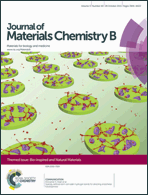Journal of Materials Chemistry B is pleased to announce the publication of the Bio-inspired and natural materials themed issue.
Bio-inspired and naturally-derived materials may derive their structure, crosslinking, fabrication or application from biological sources. Of particular interest are materials that are self-assembled, hierarchically structured, biologically active, dynamic, responsive or adaptable. Potential applications are diverse and include the medical, bioprocessing, environmental, energy, consumer or military fields. This themed issue aims to cover the most recent progress in the synthesis, processing and characterization of bio-inspired and natural materials, to highlight the new development in synthesis, engineering, and application of these materials.
The collection was Guest Edited by Jennie B. Leach (UMBC, USA) and Molly S. Shoichet (University of Toronto, Canada)
Below are a selection of some of the high quality articles, and the full collection can be found here.
Strategies for skeletal muscle tissue engineering: seed vs. soil
Brian M. Sicari, Ricardo Londono and Stephen F. Badylak
J. Mater. Chem. B, 2015, 3, 7881-7895
DOI: 10.1039/C5TB01714A
Mimicking biological phenomena in hydrogel-based biomaterials to promote dynamic cellular responses
Nicholas P. Murphy and Kyle J. Lampe
J. Mater. Chem. B, 2015, 3, 7867-7880
DOI: 10.1039/C5TB01045D
Hydrogels that allow and facilitate bone repair, remodeling, and regeneration
Aaron R. Short, Deepthi Koralla, Ameya Deshmukh, Benjamin Wissel, Benjamin Stocker, Mark Calhoun, David Dean and Jessica O. Winter
J. Mater. Chem. B, 2015, 3, 7818-7830
DOI: 10.1039/C5TB01043H























